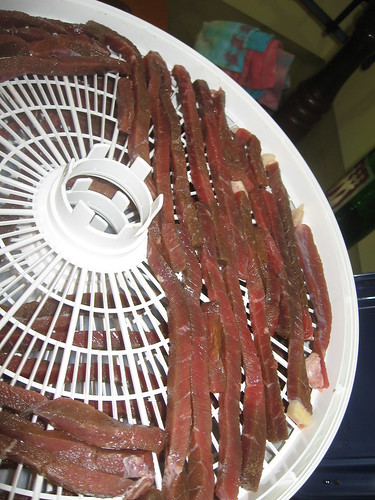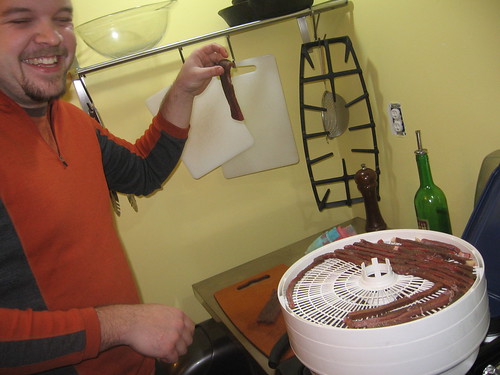We are posting this for Labor Day weekend in honor of all the people like us enjoying a family camp out this weekend. We will spend 3 days at East Harbor State Park on the Lake Erie shore. Expect another camp food post when we get home! So in line with all of our efforts to preserve/store food, Rachel had the idea that I should write a short post on making jerky. The advantage to jerky is that it helps preserve meat for longer term storage than if it were fresh. And, it tastes delicious!
Meat will still spoil eventually in jerky form but it will take much longer than raw meat. Simple refrigeration will serve to keep jerky for an extended period of time (6 months +).
So what do you need to make jerky? There are really only three elements: meat, seasoning/cure/marinade, and a drying device.
To start, what meat should you use? Really you can use anything. I have successfully used beef, bison, turkey, chicken, pork and even salmon. I find I have the best luck with beef/bison and turkey. You can use most any cut, but I would suggest something cheap as it is simply not necessary to buy a good, tender cut of meat and then process the crap out of it to make jerky. For beef/bison, use round roast, rump roast, sirloin or the like. For turkey, I just use plain turkey breast. I like to cut the meat into thin strips prior to the marinating step so that the meat can get full exposure to the flavorings. Cut the strips as thin as possible to aid drying later on.

For the seasoning or marinade there are two schools of thought. You can either use a dry rub with lots of salt and or use a wet marinade. Either way, you need to ensure that the salt content is high to promote preservation and drying of the meat (salt helps remove moisture content from meat). My preference is a wet marinade made with equal parts oil and soy sauce, 1/4 part of lemon juice and then whatever herbs or spices I have around. Sometimes I use cayenne pepper for an extra kick or just thyme/oregano for a more savory flavor. Marinate or let it sit in the rub in the refrigerator until the meat feels firm rather than tender and you are ready to go. This should usually be 2-7 days.
For drying, you can use a dehydrator, oven on lowest setting, racks in the sun and smoking with low heat. Currently we use a dehydrator as it is the easiest method and causes the least mess.

Smoking is especially good if you want to impart extra flavor, but be warned that meats like chicken and turkey can really absorb the smoky flavor to an extent that they may become unpleasant to eat.
The oven is simple as most people have one. Keep the temperature low enough (less than 200 deg F) to avoid cooking the meat, which can be achieved by keep oven at lowest setting with the door open or leaving the pilot light of a gas stove lit.
Sun drying can be contentious as many people are wary of leaving meat outside in the warm air for that long. I find it works fine, you just have to figure out some way to keep critters off your product.
The meat must be thoroughly dry before you consider it done, usually 12 - 18 hours. Try splitting a piece in half. It should release no moisture and feel tough.
When it is finished, jerky can be stored in a container in the fridge for months. Also, it can be taken hiking or outdoors with no refrigeration for multiple days at a time with no problem. The salt combined with moisture removal does an excellent job of keeping the meat preserved.
